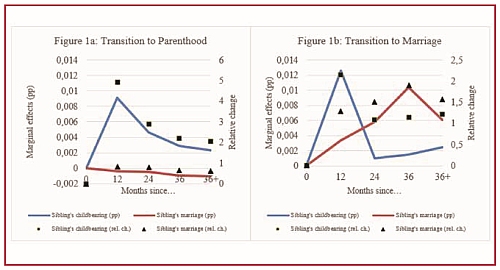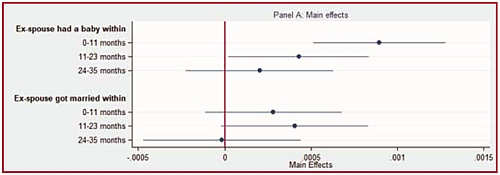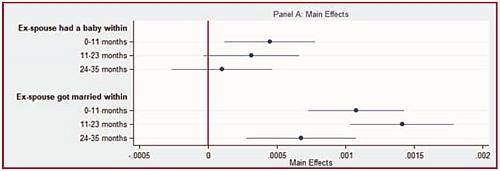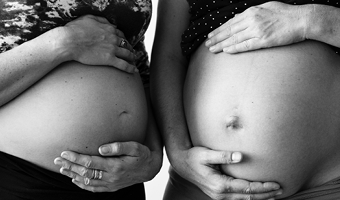Network Effects on Fertility
This project aims to provide a comprehensive quantitative assessment of social interaction effects on fertility. Specifically, we ask whether fertility is “contagious” within the family, within the circle of friends, and at the workplace. These questions derive from a compelling theoretical idea that is increasingly recognized in recent research on fertility: The decision to have a child may spread across network partners through social interaction. This claim has been substantiated by a novel line of research which studies contagion effects on fertility within different domains of social interaction. Although the literature in this pioneering area is growing steadily, it still leaves considerable gaps in knowledge about the social contagion of fertility.
Study 1 – Sibling Influence on Family Formation: A Study of Social Interaction Effects on Marriage and Fertility
Using panel data from the German SOEP (1984 – 2015; N = 1,735 sibling dyads), we estimated multilevel discrete-time hazard models with random effects at the individual and family level to examine whether siblings’ transitions to marriage and parenthood influence an individual’s chance to get married and to have children. Using a simultaneous equations model, transitions to parenthood and marriage were estimated jointly, allowing for correlations between the unobserved individual characteristics that affect marriage and parenthood.
To assess endogenous sibling effects on family formation behavior, we specify multilevel models representing monthly occasions within individuals and individuals within the family. We estimate the two hazards of entry into childbearing and marriage simultaneously and allow for correlations across unobserved characteristics at the individual-level of these two processes.
As illustrated in Figure 1, results show that the probability of becoming a parent increased substantially in the year after a sibling had a child. Similarly, the probability of getting married increased after the first year following a sibling’s marriage. We also found evidence for social interaction effects across different transitions in the process of family formation, as the probability of getting married increased further after a sibling had a child, and especially if this sibling was also married.
Study 2 – Family, Firms, and Fertility: A Study of Social Interaction effects
The present study uses instrumental variables to improve the identification of social interaction effects on fertility. Using data from the System of Social statistical Datasets (SSD) of Statistics Netherlands, we identify two networks – the network of siblings in the family and the network of colleagues at the workplace – to examine the influence of network partners on individual fertility decisions.
Figure 1: Predicted marginal effects of sibling’s entry into marriage and parenthood on Transition to Parenthood and Marriage

In order to disentangle social interaction effects from contextual and selection effects, we employed exclusion restrictions and instruments that were related to predictors, but not to the outcome. To assess colleague effects on fertility, we used information on the fertility of colleagues’ siblings as an instrument. Conversely, we used the fertility of siblings’ colleagues as an instrument to identify direct sibling effects as shown in Figure 2. This approach allowed us not only to disentangle social interaction effects from other effects, but also to examine social spillover effects in fertility from (i) the family to the workplace, and (ii) from the workplace to the family.
Discrete-time event history models with random effects provide evidence for social interaction effects, showing that colleagues’ and siblings’ fertility have direct consequences for an individual’s fertility. Furthermore, our results are the first to demonstrate spillover effects across network boundaries, suggesting that fertility effects accumulate through social ties not only within but also across different domains of interaction.
Figure 2: Identification of Social Interaction Effects

Study 3 – Former Spouse’s Influence on Family Formation:If (s)he can do it, I can do it too
Using data from the System of Social statistical Datasets (SSD) of Statistics Netherlands, we followed divorcees over time to examine interdependencies in their post-divorce family formation behavior.
The probability of having a child and transition to marriage after a divorce was estimated by fixed-effects linear probability models for monthly observations nested in persons (Allison 2009). These models only focused on within individual changes over time and how these were related to the outcome. By definition, only factors that vary within individuals over time entered the models and all observed and unobserved time-constant heterogeneity was rendered inconsequential.
Results show that the probability of having a child increased in the year after a former spouse had a child (see Figure 3). Similarly, the probability of getting married increased following a former spouse’s marriage as shown in Figure 4. We found evidence for the influence of former spouses across different transitions in the process of family formation, as the probability of getting married increased further after a former spouse had a child.
Figure 3: Predicted effects of an ex spouse’s entry into marriage and parenthood on transition to parenthood

Figure 4: Predicted effects of an ex spouse’s entry into marriage and parenthood on the risk of remarriage

Photo by rawpixel on Unsplash

